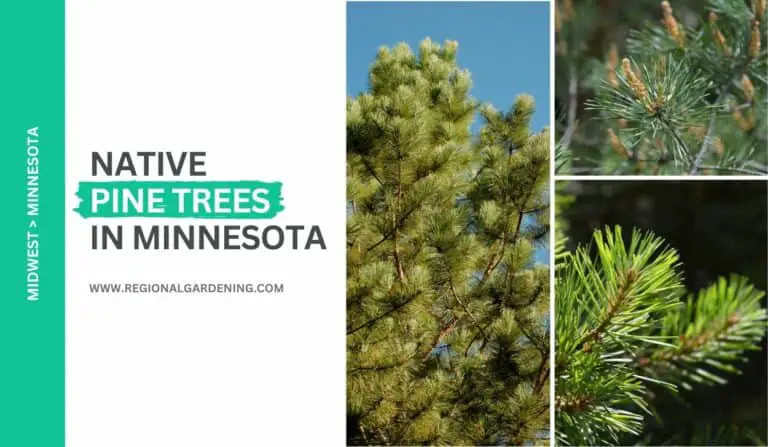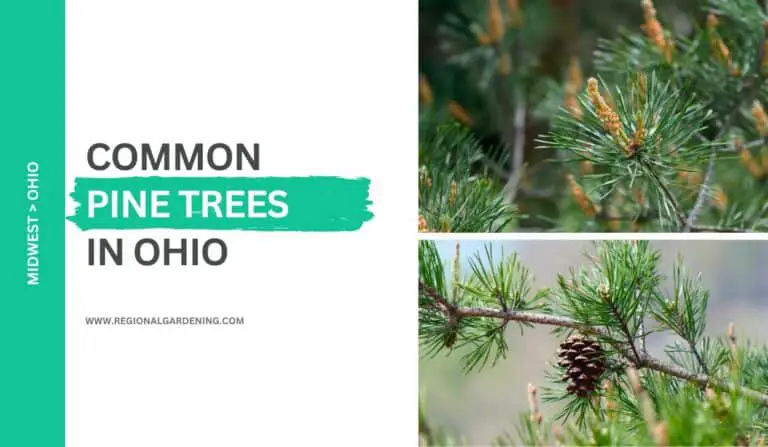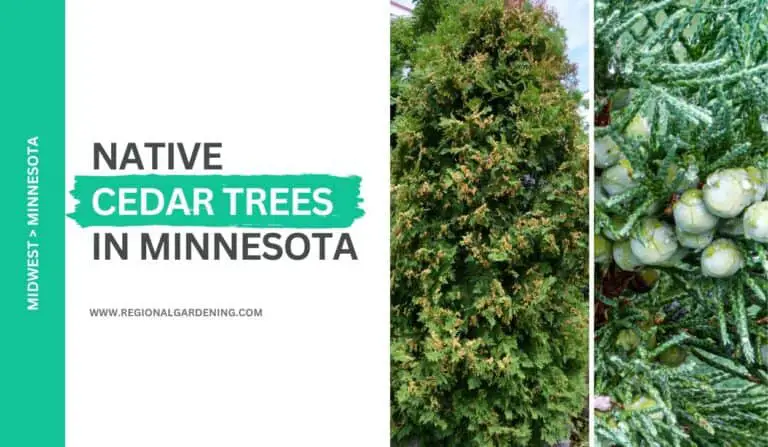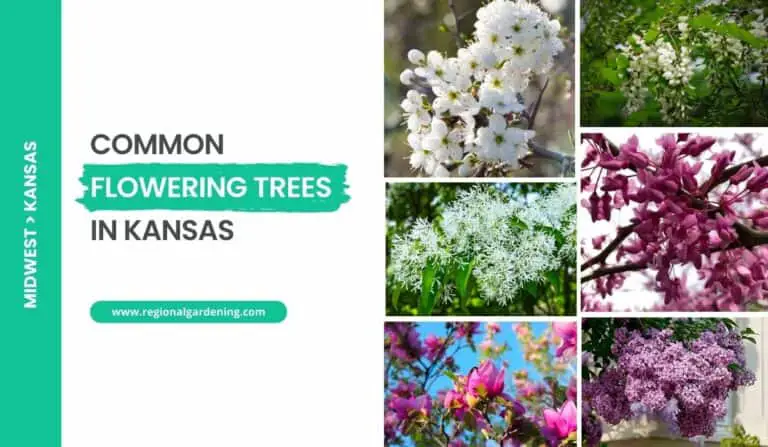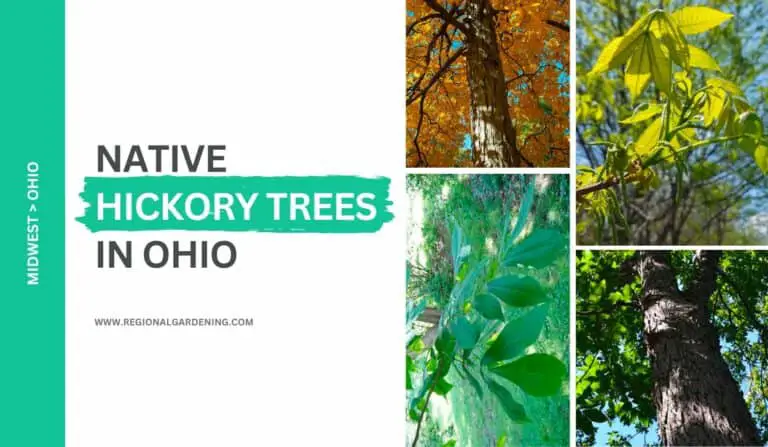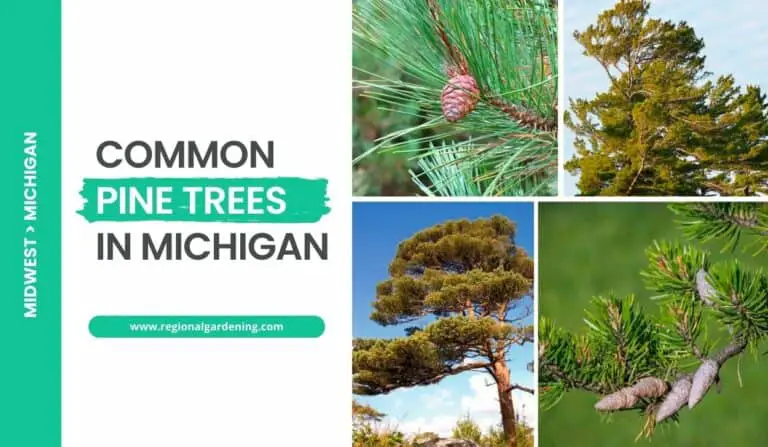7 Yellow Flowering Trees In Michigan (Photos & Care Tips)
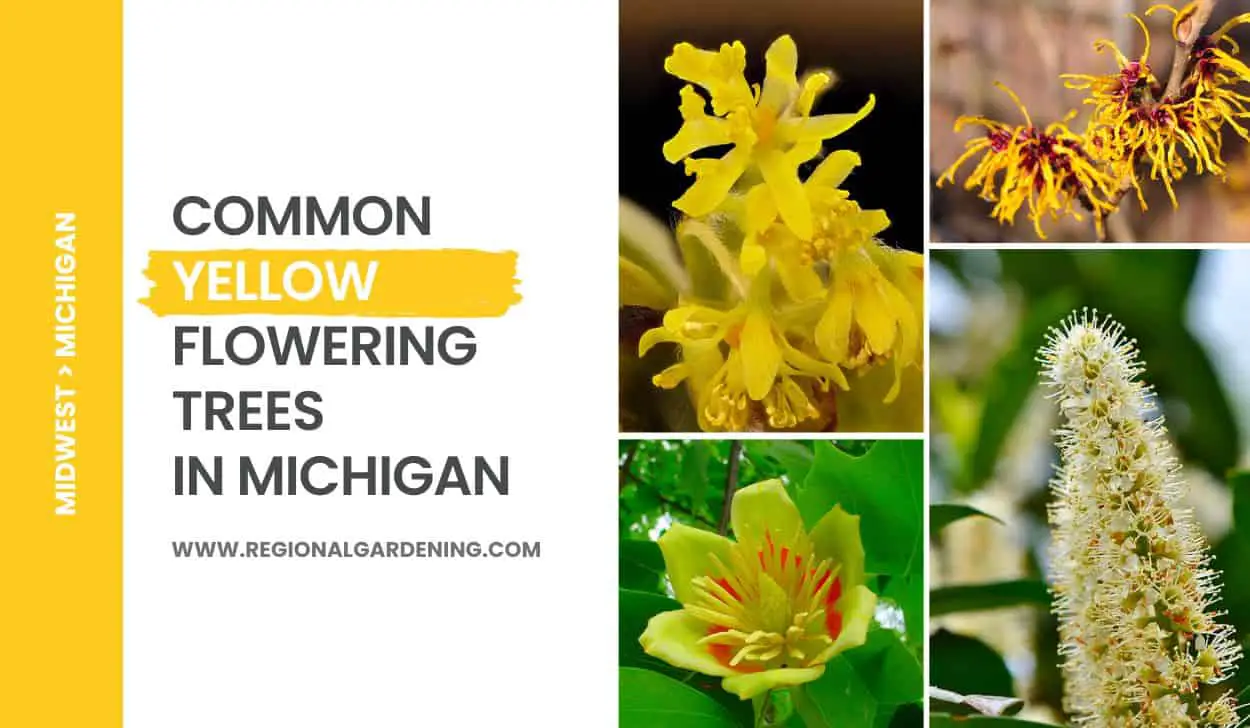
Yellow is a color that is usually added to brighten up a backyard garden. If you live in Michigan and are looking for some amazing yellow flowers, then you are in luck.
The landscape of Michigan is full of vibrant trees and plants that bloom all year. Even though white has the most trees, yellow comes in second. And, in this article, I’ll walk you through 7 of the most common yellow flowering trees in Michigan, including identification, habitat, range, and uses.
So, let’s get started.
1. American Basswood
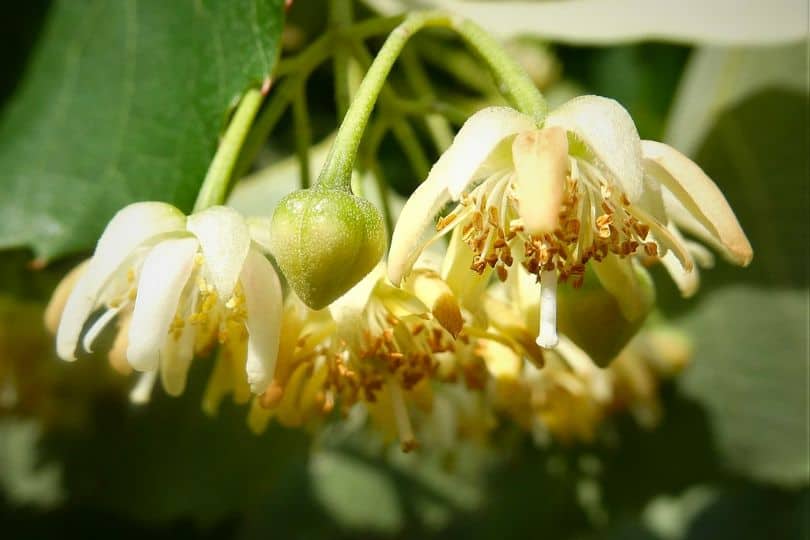
- Common Name: American Basswood
- Scientific Name: Tilia americana Linden (Tiliaceae)
- Mature Height: 50–70 feet (15–21 meters)
- Native/Non-Native: Native
- Flowers/Cones: Creamy yellow flowers, nut-like green fruit
- Uses: Carving, honey production, fiber for weaving mats, rope, and baskets
American Basswood is the most common and beautiful species among yellow flowering trees in Michigan. It is often referred to as American Linden or Basswood.
American Basswood tree can reach a height of 70 feet and has a full circular crown. It has heart-shaped leaves that are 3 to 7 inches long and dull green on top and lighter green on the bottom. The leaves have asymmetrical leaf bases and sharp-toothed edges.
The American Basswood has fragrant, creamy yellow flowers that are about 1 to 2 inches in diameter in the summer. Bees make high-quality honey from these flowers. The tree also produces nut-like green fruit that matures to yellow. These fruits have a quarter-inch diameter and are covered with light brown hairs. They are suspended in bunches from a leaf-like wing.
In the fall, the leaves of the American Basswood turn yellow and orange. This tree prefers moist soils and can tolerate shade. It has a lifespan of up to 200 years, but it is frequently cut short due to storm or insect damage.
The lightweight and soft wood of American Basswood makes it a favorite carving material. Also, American Indians used to make mats, rope, and baskets out of the tree’s fibrous inner bark. This tree has numerous cultivated variations.
2. Mountain Maple
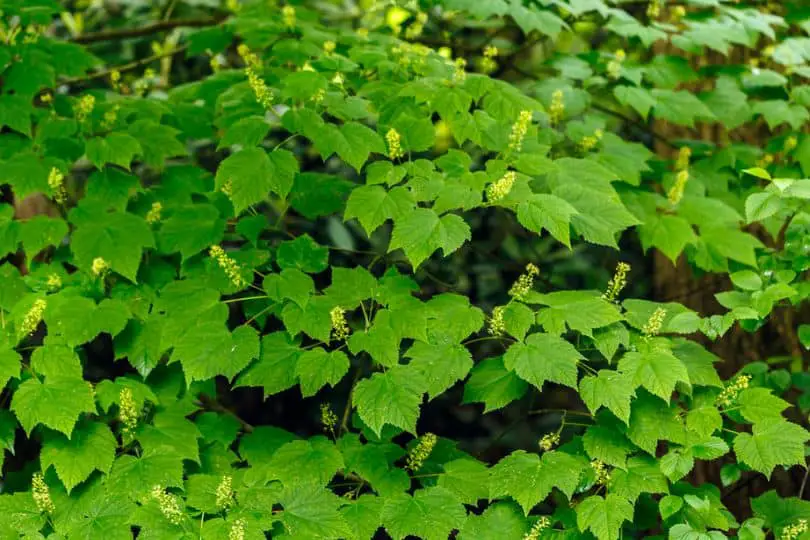
- Common Name: Mountain Maple
- Scientific Name: Acer spicatum
- Mature Height: 20–30 feet (6–9 meters)
- Native/Non-Native: Native
- Flowers: Flowers
- Uses: Not used commercially
The Mountain Maple is a tiny, crooked tree with a single trunk and upright branches that can reach 30 feet in height. The tree has an uneven crown and 2-4-inch-long leaves with three (occasionally five) pointed lobes and coarse-toothed margins. The leaves are light green, with a crimson leafstalk that is longer than the leaf. Yellowish-green blooms appear in spike clusters on the tree, which can reach a height of 3 inches.
The tree produces fruit in the form of winged seeds that are often brilliant red in the spring before turning yellow and brown in the summer. The seeds, which are about 34-1 inch long, fall in the early winter. Mountain Maple grows well in wet areas, such as along streams, and tolerates shade.
This tree is often seen growing beneath the canopy of larger, more dominant trees, and it does not do well in open areas. It is also known as the Moose Maple because it grows in moose habitats. Because of its shallow root system, the Mountain Maple is not widely used for commercial purposes. It’s a beautiful natural tree to look for on hikes or excursions in North America near moist areas.
3. Tulip Tree
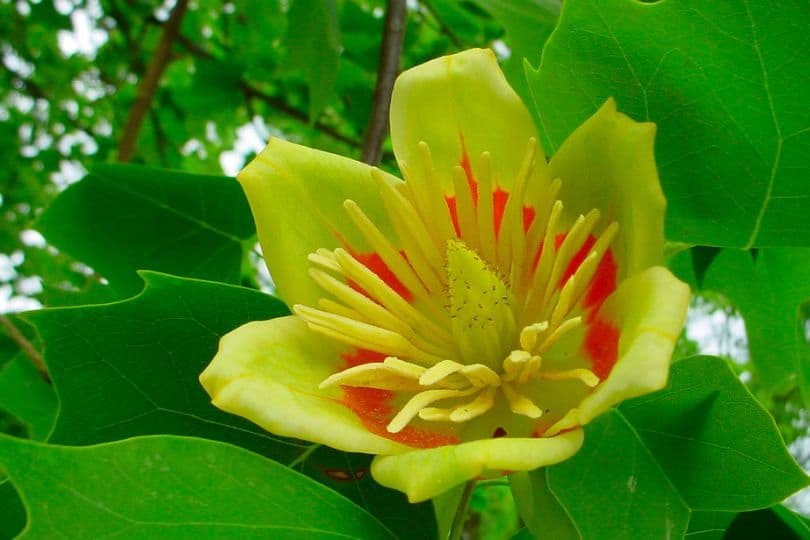
- Common Name: Tulip-tree
- Scientific Name: Liriodendron tulipifera
- Mature Height: 80-100 feet
- Native/Non-Native: Native
- Flowers: Large, showy, tulip-shaped flower; long cone-like green fruit
- Uses: A tonic from its bitter, aromatic roots was used for heart ailments.
Tulip trees are one of the most common yellow flowering trees in Michigan. It is a massive, majestic tree that can reach heights of 100 feet.
It has a single, straight trunk with branches that begin higher up the tree, giving it a thin crown. Tulip-tree leaves are distinctive, with some virtually square and others having four to six pointed lobes. They have a glossy green top and a paler underside. The tree’s bark is gray and heavily furrowed.
The flowers of the Tulip tree are enormous and beautiful, with bright yellow-green petals and orange bases. They have the appearance of tulips, which is how the tree got its name.
The fruit of the tree is cone-shaped and green while young, but matures to a light brown color. There are small winged nutlets inside the cone that split apart in autumn and release seeds.
Tulip trees are native to Michigan and have a lifespan of up to 150 years, the highest among all other yellow flowering trees in this list. They prefer moist soils near streams, ponds, and other bodies of water. These trees can be found in the southern portion of the United States.
One unique aspect of this tree is that as it grows larger, it sheds its lower leaves. A tonic produced from its roots was also used to treat cardiac problems.
4. Sassafras
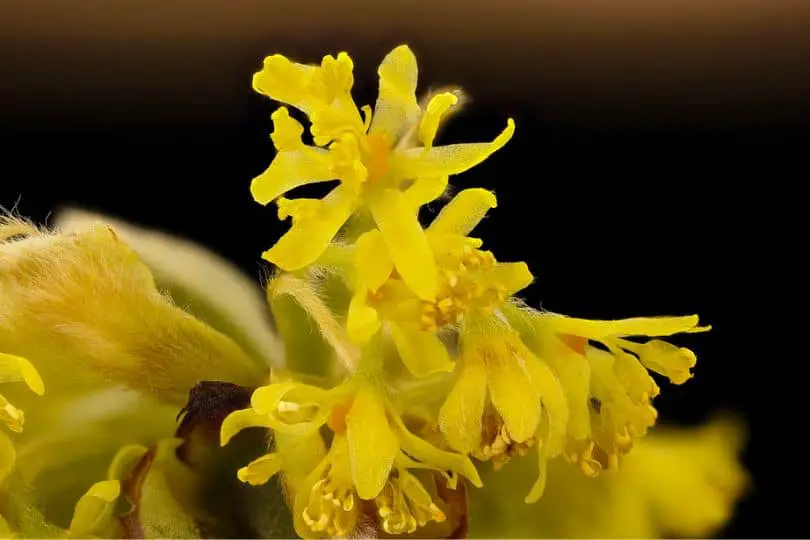
- Common Name: Sassafras
- Scientific Name: Sassafras albidum Laurel (Lauraceae)
- Mature Height: 30-60 feet (9-18 meters)
- Native/Non-Native: Native
- Flowers: Green-to-yellow flowers in clusters, blue to nearly black fruit in clusters
- Uses: Mostly as ornamental
Sassafras is a medium-sized, columnar tree that can reach heights of 30-60 feet (9 to 18 meters). It has a single crooked trunk and branches that frequently curve and spread, resulting in a flat uneven crown.
The leaves of the Sassafras tree vary in shape and size, with some being elliptical and others having one, two, or three lobes, giving them a mitten-like appearance. The leaves have a hairy brown texture and are glossy green on top and lighter on the bottom. The margins of the leaves are smooth and toothed.
The tree produces green-to-yellow flowers in 14-inch (.6 cm) wide clusters, as well as blue to nearly black fruit in 12-inch (1 cm) diameter clusters. The fruit stalks are one inch (2.5 cm) long and have one seed.
Sassafras is native to many southern and midwestern states in North America. It prefers moist to dry soil and can grow in both full and partial sun. The tree’s leaves and twigs emit a spicy aroma when crushed, and its shallow roots were traditionally used to produce sassafras oil for perfuming soap.
Sassafras is a Native American plant that was once thought to have medicinal properties. Tea was made from its bark and roots by early settlers. Because of its fall colors and fruit, the tree is occasionally planted as an ornamental because it provides dense shelter and fruit for wildlife. However, due to the fragility of its wood, it does not reach full maturity in northern states.
5. Witch Hazel
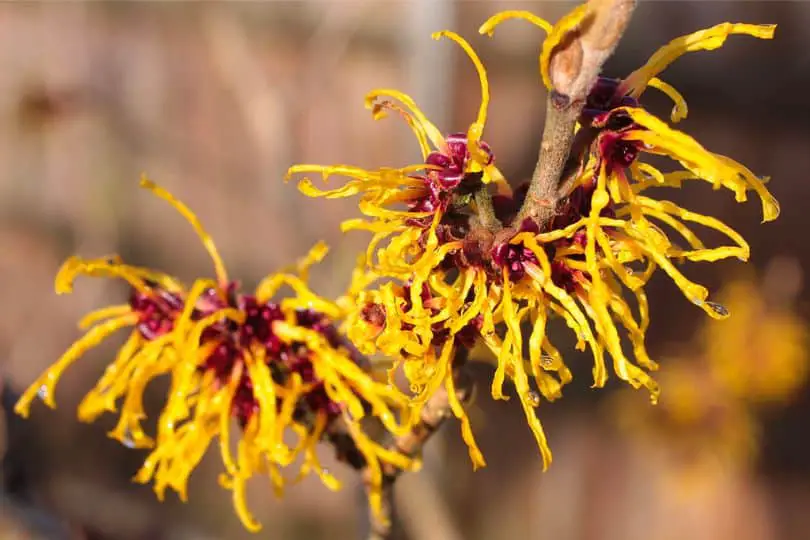
- Common Name: Witch-hazel
- Scientific Name: Hamamelis virginiana
- Mature Height: 20-30 feet (6-9 meters)
- Native/Non-Native: Native
- Flowers/Cones: Bright yellow flowers
- Uses: Medicinal astringent in washes
Witch Hazel is one of the very few yellow flowering trees in Michigan that blooms in the fall. It is a small tree that can reach 20-30 feet. It has several slender, crooked trunks and spreading branches that together form a sizable open crown.
The leaves are simple, oval to circular, and 3-6 inches long. They have pointy or rounded points, and uneven bases, and are attached alternately. The leaves are dark green on top and slightly lighter below, with an uneven wavy edge and coarse teeth.
The Witch-hazel has vivid yellow flowers with four long thin twisted petals in the autumn. The blooms appear in threes at the joint where the leaf joins to the twig. In addition, unlike most other trees, witch-hazel blooms in the fall.
The Witch-hazel fruit is a green capsule that turns orange and rips open the following fall. It has two tiny, gleaming black seeds. Even after the seeds have fallen to the ground, the capsules stay on the tree for several years.
Witch-hazel is a North American native that can live for 30-50 years. It enjoys shade and grows best in damp soils. It can be found in the understory of deciduous forests.
Surprisingly, this tree’s forked branch was thought to have the ability to discover subsurface water. Witch-hazel leaves, twigs, and bark are scented and have been used as an astringent in therapeutic washes. The name “Hazel” stems from the resemblance of the leaves to those of the hazel shrub. Overall, the Witch-hazel is an interesting and distinctive tree!
6. Laurel Willow
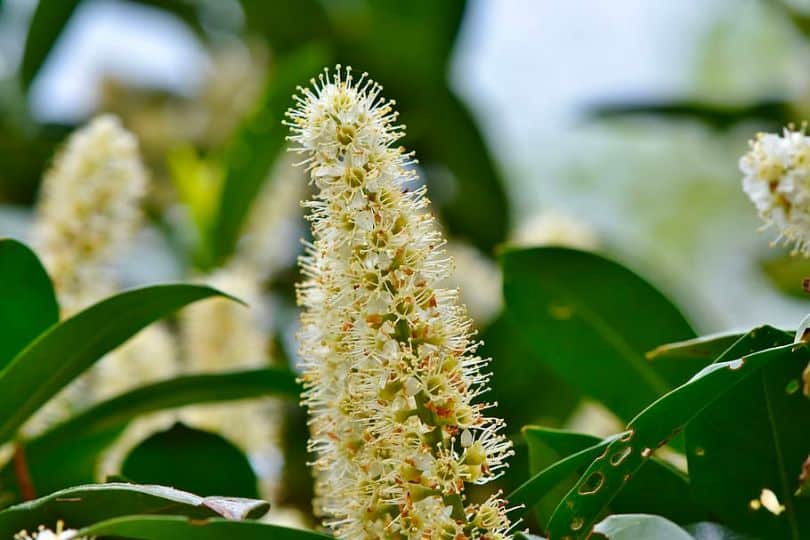
- Common Name: Laurel Willow
- Scientific Name: Salix pentandra
- Mature Height: 25–45′ (7.5–14 m)
- Native/Non-Native: Non-native, introduced from Europe and western Asia; 20–40 years
- Flowers: Golden yellow catkin, 1–2″ (2.5–5 cm) long, on a short stalk
- Uses: Leaves have been used for flavoring foods
Laurel Willow trees are the most common non-native yellow flowering trees in Michigan. It is a short-lived tree that grows quickly. Despite being a non-native tree, it is one of Michigan’s most successful willow species.
The leaves of the Laurel Willow are round and irregular in shape, with a prominent yellow midrib. They measure 2-5″ (5-12.5 cm) in length, are lance-shaped, and alternately connected, with a pointy tip and fine-toothed border. When crushed, the leaves are lustrous dark green on top and dull green on the bottom, with a pleasant scent.
The Laurel Willow has been planted in yards, parks, and along roadways in shelterbelts because it is a disease-free species. It is found throughout the region in wet acid soils, isolated in and around cities and parks, and thrives well north into Canada.
During the fall, the tree produces yellow non-edible catkin-like fruit that is 1-2″ (2.5-5 cm) long and composed of many 14″ (.6 cm) long capsules that contain seeds. During the autumn season, the color of the leaves also changes. The tree’s leaves frequently remain on the tree until autumn.
7. Russian Olive
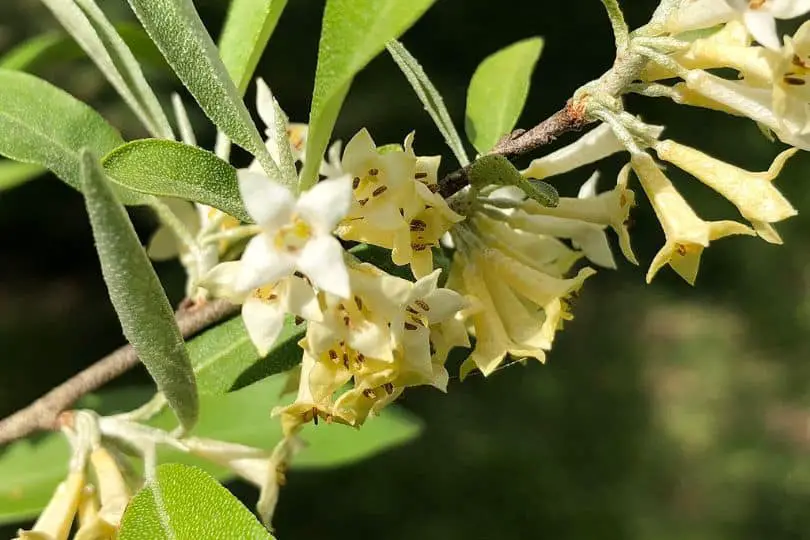
- Common Name: Russian-Olive
- Scientific Name: Elaeagnus angustifolia
- Mature Height: 10-20 feet (3-6 meters)
- Native/Non-Native: Non-native (introduced from Europe)
- Flowers: 4-petaled yellow flowers, olive-like fruit
- Uses: Planted for its unusual gray leaves and fruit, used as a shelterbelt
Russian Olive trees are the second most commonly seen non-native species among yellow flowering trees in Michigan. They are brought to North America from Europe between 50 and 75 years ago.
This tree has an open uneven crown and a narrow, single crooked trunk that is often divided low. The leaves are simple, lance-shaped, and gray above and below, measuring 1-4 inches (2.5-10 cm) in length. Grayish-white hairs cover the leaves and twigs.
In the fall, the Russian Olive produces dry gray-to-yellow olive-like fruit 14-12 inches (0.6-1 cm) in diameter with one seed. The tree also produces 4-petaled yellow flowers measuring 14-12 inches (0.6-1 cm) across.
The Russian Olive Tree, which was previously planted as an ornamental, can often be found near historic farmsteads and parks. It is no longer grown in gardens, yards, or parks, but it has escaped and is now growing in the wild. This tree spreads quickly because it survives the digestive tracts of birds.
The twigs of a Russian Olive Tree are often scaly and armed with very long thorns with salmon-colored pith. Even though, the Russian Olive Tree is not native to Michigan, it has become naturalized here. It is unique gray foliage and olive-like fruit make it an eye-catching tree.
Similar Articles
- Native Birch Trees In Michigan
- Native Elm Trees In Michigan
- Common Nut Trees In Michigan
- Common White Bark Trees In Michigan
- Common Ash Trees In Michigan
- Common Willow Trees In Michigan
- Common Spruce Trees In Michigan
- Red Flowering Trees In Michigan
- Common Maple Trees In Michigan
- Purple Trees In Michigan
- White Flowering Trees In Michigan
- Common Hickory Trees In Michigan
- Common Oak Trees In Michigan
Yellow Flowering trees In Michigan – Sources
The Regional Gardening team makes sure that the information in our articles is accurate by only using sources that are known to be trustworthy. Some of these sources are peer-reviewed journals from government agencies, well-known universities, and scientific research organizations.
- Book – Michigan Trees A Guide to the Trees of the Great Lakes Region
- Book – Field Manual of Michigan Flora
- Book – Trees Of Michigan Field Guide
- Michigan’s Forests, Department of Natural Resources
- Michigan Botanical Society
- LSA Herbarium, University Of Michigan
- Department Of Forestry, Michigan State University
- Michigan Nature Association


